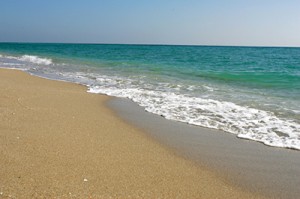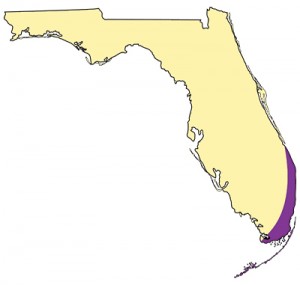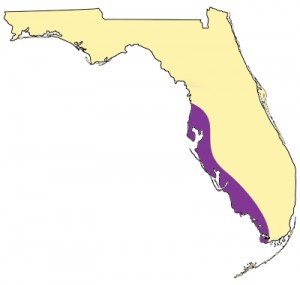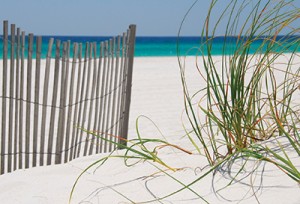Florida Beach Camping Guide
 What could be better than spending the day at your favorite Florida beach? Spending the night! Some of the best campsites can be found along Florida’s coastline, from primitive tent camping to hotel-quality cabins.
What could be better than spending the day at your favorite Florida beach? Spending the night! Some of the best campsites can be found along Florida’s coastline, from primitive tent camping to hotel-quality cabins.
Most beach campsites are located in the slightly sheltered area behind the sand dunes. Camping directly on the beach (near the waves) is not usually permitted for safety reasons and to protect wildlife, such as sea turtles and nesting birds. The season and your shelter preference can help determine the site selection. For example, in the winter months, humidity is lower, breezes are refreshing, and bugs are at a minimum in the Florida Keys. The summer months, however, entice campers to the emerald green waters of northwest Florida, which may be a bit too cool during winter. Tent campers are more exposed to weather conditions than RV campers who, of course, have access to heaters and air-conditioning. Florida State Park campgrounds generally accommodate both tents and RVs, often allow pets, and are ADA accessible.
South Florida & The Keys
 Long Key State Park: Located at mile marker 67.5 on Long Key, this campground offers 60 campsites on the Atlantic Ocean for both tents and RVs. The island and beach are narrow, but the offshore coral reefs block the open ocean swells, resulting in calm, shallow water.
Long Key State Park: Located at mile marker 67.5 on Long Key, this campground offers 60 campsites on the Atlantic Ocean for both tents and RVs. The island and beach are narrow, but the offshore coral reefs block the open ocean swells, resulting in calm, shallow water.- Curry Hammock State Park: Located at mile marker 56.2 on Little Crawl Key, the park offers 28 campsites about 100 feet from the ocean. The 1,200-foot, sandy beach is perfect for sunbathing, launching a kayak, or building sandcastles.
- Bahia Honda State Park: Located at mile marker 37, this popular, scenic park boasts lush coconut palms against a backdrop of white sand and clear tropical waters and is widely considered to be the best beach in the Keys! It has three campgrounds (totaling 80 campsites) for tents, RVs, and duplex cabins.
- Biscayne National Park: Although most of the park is underwater, there are sub-tropical islands close to Miami (for experienced campers). There are no cars, roads, or bridges to these islands, so you’ll need your own boat or arranged transportation. Elliott Key, the largest island, is forested with tropical hardwoods and features flush toilets, cold showers, and drinking water. Boca Chita Key has saltwater flush toilets, but no fresh water. Mosquitoes and no-see-ums can sometimes be an issue during the summer months. The beaches are small and rocky, but ideal for fishing and snorkeling (Florida saltwater fishing license required).
Central & Northern Atlantic Coast
 Sebastian Inlet State Park: The jetty, popular with fishermen and surfers, is on the north side of the inlet; the camping area is on the south side. With three miles of beaches, a boat ramp, and the Indian River Lagoon for canoeing, kayaking, and fishing, you’ll never run out of things to do.
Sebastian Inlet State Park: The jetty, popular with fishermen and surfers, is on the north side of the inlet; the camping area is on the south side. With three miles of beaches, a boat ramp, and the Indian River Lagoon for canoeing, kayaking, and fishing, you’ll never run out of things to do.- Canaveral National Seashore: You can camp right on the beach in this pristine paradise (November through April). The campsites are a quarter-mile walk from the parking area, and restrooms are also nearby. The park boasts 24 miles of undeveloped beach with only two camping areas – one accommodates 6 people, and the other 15 – so don’t expect a crowd. Fires are allowed in metal containers, except during dry periods.
- Gamble Rogers Memorial State Recreation Area: Located at Flagler Beach, the campsites are just behind the dunes. The 34 campsites, bordered by a variety of coastal plant life, offer electricity and water. Shade is scarce, but almost constant sea breezes keep campers cool and chase away bugs.
- North Beach Camp Resort: Located in St. Augustine, this site offers a variety of outdoor activities to enjoy between the ocean and the North River.
Southwest Florida’s Gulf Coast
 La Costa Island: Since there are no roads or bridges to this island, the Tropic Star, departing from Bokeelia on Pine Island, ferries passengers to Cayo Costa State Park daily. La Costa is a fairly large and mostly undeveloped island between North Captiva and Boca Grande. The camping area is behind the small dunes and just steps from a crescent-shaped beach. Several 6-person cabins are available; however, none of the sites have electricity or water. Showers and flush toilets are available, as is drinking water. You may find that you have the beach practically all to yourself.
La Costa Island: Since there are no roads or bridges to this island, the Tropic Star, departing from Bokeelia on Pine Island, ferries passengers to Cayo Costa State Park daily. La Costa is a fairly large and mostly undeveloped island between North Captiva and Boca Grande. The camping area is behind the small dunes and just steps from a crescent-shaped beach. Several 6-person cabins are available; however, none of the sites have electricity or water. Showers and flush toilets are available, as is drinking water. You may find that you have the beach practically all to yourself.- Red Coconut RV Resort: Located on Fort Myers Beach, many RV campers (rentals available) return to its palm fringed shores year after year, forming a little beach community. It’s close to all the conveniences of Fort Myers Beach and is on a trolley stop so expect some traffic noise.
- Fort De Soto County Park: Many of its campsites are situated on the calm backwater, with the award-winning beach just a short drive or paddle away. Mature trees provide thick shade, with a heavenly breeze coming off the water. Both tents and RVs are accommodated with available electricity and water. Enjoy bike and kayak rentals, two fishing piers, and a historical fort.
Northwest Florida
 Pensacola area: Johnson Beach, part of Gulf Islands National Seashore on Perdido Key, offers primitive camping, with some sand-hiking on its far eastern edge. Sugar-white sand, rolling dunes, and wetlands make up the landscape of this peaceful spot. Just across the bridge from Perdido Key, you can find Big Lagoon State Park, which boasts 655 acres including beaches, shallow bays, nature trails, and open woodlands. It’s a haven for nature lovers ─ kayaking, hiking, fishing, birding, etc. ─ with 75 campsites (RVs and tents) equipped with water and electricity. Fort Pickens, on the west end of Pensacola Beach, features a historic fort and another 200 campsites (tents and RVs up to 50 feet) with water, electricity, and picnic tables.
Pensacola area: Johnson Beach, part of Gulf Islands National Seashore on Perdido Key, offers primitive camping, with some sand-hiking on its far eastern edge. Sugar-white sand, rolling dunes, and wetlands make up the landscape of this peaceful spot. Just across the bridge from Perdido Key, you can find Big Lagoon State Park, which boasts 655 acres including beaches, shallow bays, nature trails, and open woodlands. It’s a haven for nature lovers ─ kayaking, hiking, fishing, birding, etc. ─ with 75 campsites (RVs and tents) equipped with water and electricity. Fort Pickens, on the west end of Pensacola Beach, features a historic fort and another 200 campsites (tents and RVs up to 50 feet) with water, electricity, and picnic tables.- St. George Island State Park: Just offshore from Apalachicola, find nine miles of white-sand beaches that house 60 campsites, located between the Bay and Gulf. Nestled under a canopy of pines, sites offer electricity, water, and a central dump station. The primitive camping spot, located at the end of a two-and-a-half mile trail, is also accessible by canoe or kayak. There are no facilities or water at the primitive camp, whereas the group camp site is designed for organized groups and offers a restroom and cold showers. With a special permit and additional fee, fishermen can access East Pass to reel in redfish, mackerel, trout, whiting, and flounder.
 St. Joseph Peninsula State Park: Ten miles of secluded beaches that are favored by nesting Loggerhead turtles and beachcombers alike! Located near Port St. Joe, the park offers two areas with 119 campsites, complete with water and electricity. Gulf Breeze is open to the sea breeze, but lacks shade. Shady Pines is appropriately named for its ample shade provided by large pines, oaks, and palm trees. There are 8 fully furnished, AC/heated cabins that can sleep up to 6.
St. Joseph Peninsula State Park: Ten miles of secluded beaches that are favored by nesting Loggerhead turtles and beachcombers alike! Located near Port St. Joe, the park offers two areas with 119 campsites, complete with water and electricity. Gulf Breeze is open to the sea breeze, but lacks shade. Shady Pines is appropriately named for its ample shade provided by large pines, oaks, and palm trees. There are 8 fully furnished, AC/heated cabins that can sleep up to 6.- Camp Gulf: This site in Destin offers an assortment of RV sites, from open beachfronts overlooking the Gulf to tree shaded, grassy sites. Each is within walking distance to the Gulf of Mexico’s emerald hued waters.
- Emerald Beach RV Park: Located halfway between Pensacola and Destin on Santa Rosa Sound, this is one of the closest RV Parks to the Gulf!
- Panama City area: St. Andrews, at the east end of Panama City Beach with 176 campsites, allows you to get away from it all without being too far away. Grayton Beach State Park is a bit more remote, snuggled halfway between Panama City Beach and Destin, south of U.S. Highway 98. In addition to an award-winning beach, this campground (cabins available) gets high marks for privacy between campsites, some of which overlook a lake.
So, how can you become a happy camper? Make reservations! Florida State Parks has an online reservation system through Reserve America (ReserveAmerica.com)… It’s just like making a hotel reservation.
This article is courtesy of Visit Florida (VisitFlorida.com).







